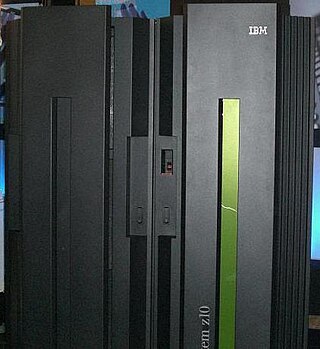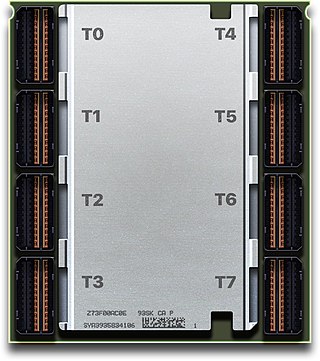Related Research Articles

A central processing unit (CPU)—also called a central processor or main processor—is the most important processor in a given computer. Its electronic circuitry executes instructions of a computer program, such as arithmetic, logic, controlling, and input/output (I/O) operations. This role contrasts with that of external components, such as main memory and I/O circuitry, and specialized coprocessors such as graphics processing units (GPUs).

A mainframe computer, informally called a mainframe or big iron, is a computer used primarily by large organizations for critical applications like bulk data processing for tasks such as censuses, industry and consumer statistics, enterprise resource planning, and large-scale transaction processing. A mainframe computer is large but not as large as a supercomputer and has more processing power than some other classes of computers, such as minicomputers, servers, workstations, and personal computers. Most large-scale computer-system architectures were established in the 1960s, but they continue to evolve. Mainframe computers are often used as servers.
Sequent Computer Systems was a computer company that designed and manufactured multiprocessing computer systems. They were among the pioneers in high-performance symmetric multiprocessing (SMP) open systems, innovating in both hardware and software.
In computing, the clock rate or clock speed typically refers to the frequency at which the clock generator of a processor can generate pulses, which are used to synchronize the operations of its components, and is used as an indicator of the processor's speed. It is measured in the SI unit of frequency hertz (Hz).
A wait state is a delay experienced by a computer processor when accessing external memory or another device that is slow to respond.

Amdahl Corporation was an information technology company which specialized in IBM mainframe-compatible computer products, some of which were regarded as supercomputers competing with those from Cray Research. Founded in 1970 by Gene Amdahl, a former IBM computer engineer best known as chief architect of System/360, it has been a wholly owned subsidiary of Fujitsu since 1997. The company was located in Sunnyvale, California.

POWER7 is a family of superscalar multi-core microprocessors based on the Power ISA 2.06 instruction set architecture released in 2010 that succeeded the POWER6 and POWER6+. POWER7 was developed by IBM at several sites including IBM's Rochester, MN; Austin, TX; Essex Junction, VT; T. J. Watson Research Center, NY; Bromont, QC and IBM Deutschland Research & Development GmbH, Böblingen, Germany laboratories. IBM announced servers based on POWER7 on 8 February 2010.
z/Architecture, initially and briefly called ESA Modal Extensions (ESAME), is IBM's 64-bit complex instruction set computer (CISC) instruction set architecture, implemented by its mainframe computers. IBM introduced its first z/Architecture-based system, the z900, in late 2000. Later z/Architecture systems include the IBM z800, z990, z890, System z9, System z10, zEnterprise 196, zEnterprise 114, zEC12, zBC12, z13, z14, z15 and z16.

A multi-core processor is a microprocessor on a single integrated circuit with two or more separate processing units, called cores, each of which reads and executes program instructions. The instructions are ordinary CPU instructions but the single processor can run instructions on separate cores at the same time, increasing overall speed for programs that support multithreading or other parallel computing techniques. Manufacturers typically integrate the cores onto a single integrated circuit die or onto multiple dies in a single chip package. The microprocessors currently used in almost all personal computers are multi-core.
Since the rise of the personal computer in the 1980s, IBM and other vendors have created PC-based IBM-compatible mainframes which are compatible with the larger IBM mainframe computers. For a period of time PC-based mainframe-compatible systems had a lower price and did not require as much electricity or floor space. However, they sacrificed performance and were not as dependable as mainframe-class hardware. These products have been popular with mainframe developers, in education and training settings, for very small companies with non-critical processing, and in certain disaster relief roles.

IBM Z is a family name used by IBM for all of its z/Architecture mainframe computers. In July 2017, with another generation of products, the official family was changed to IBM Z from IBM z Systems; the IBM Z family now includes the newest model, the IBM z16, as well as the z15, the z14, and the z13, the IBM zEnterprise models, the IBM System z10 models, the IBM System z9 models and IBM eServer zSeries models.

IBM System z10 is a line of IBM mainframes. The z10 Enterprise Class (EC) was announced on February 26, 2008. On October 21, 2008, IBM announced the z10 Business Class (BC), a scaled-down version of the z10 EC. The System z10 represents the first model family powered by the z10 quad core processing engine. Its successors are the zEnterprise System models introduced in 2010 and 2012.
The z10 is a microprocessor chip made by IBM for their System z10 mainframe computers, released February 26, 2008. It was called "z6" during development.
The z196 microprocessor is a chip made by IBM for their zEnterprise 196 and zEnterprise 114 mainframe computers, announced on July 22, 2010. The processor was developed over a three-year time span by IBM engineers from Poughkeepsie, New York; Austin, Texas; and Böblingen, Germany at a cost of US$1.5 billion. Manufactured at IBM's Fishkill, New York fabrication plant, the processor began shipping on September 10, 2010. IBM stated that it was the world's fastest microprocessor at the time.
The zEC12 microprocessor is a chip made by IBM for their zEnterprise EC12 and zEnterprise BC12 mainframe computers, announced on August 28, 2012. It is manufactured at the East Fishkill, New York fabrication plant. The processor began shipping in the fall of 2012. IBM stated that it was the world's fastest microprocessor and is about 25% faster than its predecessor the z196.
IBM Power microprocessors are designed and sold by IBM for servers and supercomputers. The name "POWER" was originally presented as an acronym for "Performance Optimization With Enhanced RISC". The Power line of microprocessors has been used in IBM's RS/6000, AS/400, pSeries, iSeries, System p, System i, and Power Systems lines of servers and supercomputers. They have also been used in data storage devices and workstations by IBM and by other server manufacturers like Bull and Hitachi.
The z13 is a microprocessor made by IBM for their z13 mainframe computers, announced on January 14, 2015. Manufactured at GlobalFoundries' East Fishkill, New York fabrication plant. IBM stated that it is the world's fastest microprocessor and is about 10% faster than its predecessor the zEC12 in general single-threaded computing, but significantly more when doing specialized tasks.

The IBM System/390 is a discontinued mainframe product family implementing ESA/390, the fifth generation of the System/360 instruction set architecture. The first computers to use the ESA/390 were the Enterprise System/9000 (ES/9000) family, which were introduced in 1990. These were followed by the 9672, Multiprise, and Integrated Server families of System/390 in 1994–1999, using CMOS microprocessors. The ESA/390 succeeded ESA/370, used in the Enhanced 3090 and 4381 "E" models, and the System/370 architecture last used in the IBM 9370 low-end mainframe. ESA/390 was succeeded by the 64-bit z/Architecture in 2000.
The z14 is a microprocessor made by IBM for their z14 mainframe computers, announced on July 17, 2017. Manufactured at GlobalFoundries' East Fishkill, New York fabrication plant. IBM stated that it is the world's fastest microprocessor by clock rate at 5.2 GHz, with a 10% increased performance per core and 30% for the whole chip compared to its predecessor the z13.

Power10 is a superscalar, multithreading, multi-core microprocessor family, based on the open source Power ISA, and announced in August 2020 at the Hot Chips conference; systems with Power10 CPUs. Generally available from September 2021 in the IBM Power10 Enterprise E1080 server.
References
- 1 2 Hudson, Andrew (24 July 2023). "The IBM mainframe: How it runs and why it survives". Ars Technica . Retrieved 25 July 2023.
- 1 2 Moorhead, Patrick (23 August 2021). "IBM Telum- A New Chapter In Vertically Integrated Chip Technology". Forbes . Retrieved 12 May 2023.
- 1 2 3 Johnson, Dexter (29 April 2022). "IBM's New Telum Chip Reboots the Mainframe". IEEE Spectrum . Retrieved 5 May 2022.
- ↑ Combs, Veronica (24 August 2021). "IBM's new Telum Processor is the company's first with an on-chip AI accelerator". TechRepublic . Archived from the original on 2023-03-22. Retrieved 27 August 2021.
- ↑ Sperling, Ed (26 August 2021). "New Approaches For Processor Architectures". Semiconductor Engineering. Retrieved 25 July 2023.
- 1 2 Cutress, Ian (2 September 2021). "Did IBM Just Preview The Future of Caches?". Anandtech . Retrieved 5 May 2022.
- ↑ Sebastian, Linus (5 April 2022). "I Tried to Break a Million Dollar Computer - IBM Z16 Facility Tour!" (video). YouTube . Linus Media Group . Retrieved 5 May 2022.
- 1 2 https://www.redbooks.ibm.com/redbooks/pdfs/sg248950.pdf
- 1 2 Why Do Mainframes Still Exist? What's Inside One? 40TB, 200+ Cores, AI, and more! , retrieved 2024-01-11